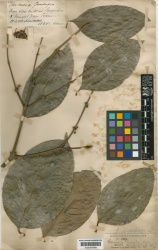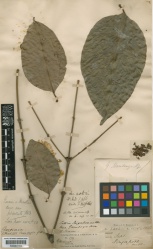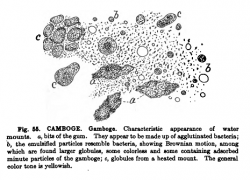Garcinia hanburyi (gum resin)
(→add category divisions and wikipedia references) |
|||
| (10 intermediate revisions by 2 users not shown) | |||
| Line 1: | Line 1: | ||
| − | = | + | {{DISPLAYTITLE:''Garcinia hanburyi'' (gum resin) }} {{askbox|herb=''Garcinia hanburyi''}} |
| + | =Nomenclature= | ||
| + | {{nomenclature | binomial=Garcinia hanburyi | ||
| + | |authority=Hook. f. | ||
| + | |family=Clusiaceae | ||
| + | |scn=gamboge | ||
| + | |syn=Hanbury's garcinia; Siam gamboge | ||
| + | |ayurvedic= | ||
| + | |pinyin= | ||
| + | |aka= | ||
| + | |notes=The gum resin of G. hanburyi is also commonly called gamboge. }} | ||
| − | + | =Botanical Voucher Specimen= | |
| − | + | {{media2 |cat=voucher | |
| − | + | | companyimage=Kewlogo.gif | |
| + | | companyURL=http://specimens.kew.org/herbarium/K000677699 | ||
| + | | mainimage=Garcinia_hanburyi_Kew_imageBarcode=K000677699_294998.jpg | ||
| + | | source=Royal Botanic Gardens, Kew. | ||
| − | + | | companyimage2=Kewlogo.gif | |
| + | | companyURL2=http://specimens.kew.org/herbarium/K000677700 | ||
| + | | image2=Garcinia_hanburyi_Kew_imageBarcode=K000677700_294999.jpg | ||
| + | | source2=Royal Botanic Gardens, Kew. | ||
| − | |||
| − | + | }} | |
| − | = | + | =Organoleptic Characteristics= |
| − | + | {| border=1 | |
| − | {{ | + | | {{Organolepsy | source=Schneider, A. (1921) The Microanalysis of Powdered Vegetable Drugs, 2nd ed. |
| − | + | | description=''Garcinia hanburyi'' | |
| − | | description= | + | | texture=Brittle, easily powdered.<br> |
| − | | texture=Brittle, easily powdered. | + | |
| color=Bright yellow. | | color=Bright yellow. | ||
| flavor=Slightly acrid. | | flavor=Slightly acrid. | ||
| − | | scent=Nearly odorless. | + | | scent=Nearly odorless. }} |
| + | {{Organolepsy | source=United States Dispensatory (1918) | ||
| + | | description=''Garcinia hanburyi'' (gum resin) is odorless; taste very acrid. [...] | ||
| + | |||
| + | It has no odor, and little taste, but, after remaining a short time in the mouth, produces an acrid sensation in the fauces.}} | ||
| + | |||
| + | |} | ||
| + | |||
| + | =Macroscopic Characteristics= | ||
| + | {| border=1 | ||
| + | | | ||
| + | {{Macroscopy | source=United States Dispensatory (1918) | ||
| + | | description=In hard, brittle, cylindrical pieces, usually hollow in the center, from 2 to 5 cm. in diameter, from 10 to 20 cm in length, externally grayish-orange-brown, longitudinally striate; fracture conchoidal, smooth, orange-red. | ||
| + | |||
| + | When rubbed with water it yields a yellow emulsion which becomes darker and almost transparent upon the addition of ammonia water. The emulsion turns green upon the addition of iodine T.S. (starch). | ||
| + | }} | ||
| + | |} | ||
| + | =Microscopic Characteristics= | ||
| + | {| border=1 | ||
| + | | | ||
| + | {{Macroscopy | source=United States Dispensatory (1918) | ||
| + | | description=The official description is [in part] as follows: | ||
| + | "The powder is bright yellow, containing few or no starch grains. When mounted in hydrated chloral T.S. and examined under the microscope the particles, for the most part, slowly dissolve, leaving scattered fragments of vegetable tissues. Not less than 65 per cent. of Gamboge is soluble in alcohol." U.S. | ||
| + | }} | ||
| + | |||
| + | {{Microscopy | source=Schneider, A. (1921) The Microanalysis of Powdered Vegetable Drugs, 2nd ed. | ||
| characteristics=The microscope reveals little that is characteristic. Fragments of vegetable tissue are sparingly present. There is no starch present. The emulsified particles resemble bacteria and show active Brownian movement. | | characteristics=The microscope reveals little that is characteristic. Fragments of vegetable tissue are sparingly present. There is no starch present. The emulsified particles resemble bacteria and show active Brownian movement. | ||
| ash=Ash should not exceed 1.5 per cent. | | ash=Ash should not exceed 1.5 per cent. | ||
| Line 27: | Line 66: | ||
| }} | | }} | ||
| − | = | + | {{Media |cat=Microscopy | source=Schneider, A. (1921) The Microanalysis of Powdered Vegetable Drugs, 2nd ed. |
| + | | mainimage=Microanalysis_powdered_vegetable_p_257_google_ver_camboge_figure.PNG }} | ||
| + | |} | ||
| + | =High Performance Thin Layer Chromatographic Identification= | ||
| − | = | + | =Supplementary Information= |
| + | =Sources= | ||
| + | <references /> | ||
Latest revision as of 20:20, 24 June 2015
Contents |
Nomenclature
Garcinia hanburyi Hook. f. Clusiaceae
Syn. Hanbury's garcinia; Siam gamboge
Standardized common name (English): gamboge
Botanical Voucher Specimen
 |
 |
|
|
|
Organoleptic Characteristics
|
Macroscopic Characteristics
|
Microscopic Characteristics
|
High Performance Thin Layer Chromatographic Identification
Supplementary Information
Sources
- ↑ Royal Botanic Gardens, Kew. http://specimens.kew.org/herbarium/K000677699
- ↑ Royal Botanic Gardens, Kew. http://specimens.kew.org/herbarium/K000677700
- ↑ Schneider, A. (1921) The Microanalysis of Powdered Vegetable Drugs, 2nd ed.
- ↑ United States Dispensatory (1918)
- ↑ United States Dispensatory (1918)
- ↑ United States Dispensatory (1918)
- ↑ Schneider, A. (1921) The Microanalysis of Powdered Vegetable Drugs, 2nd ed.
- ↑ Schneider, A. (1921) The Microanalysis of Powdered Vegetable Drugs, 2nd ed.


